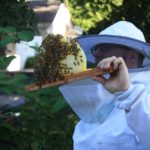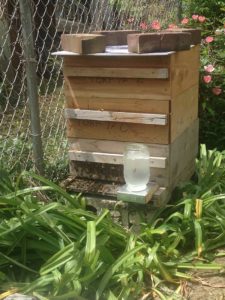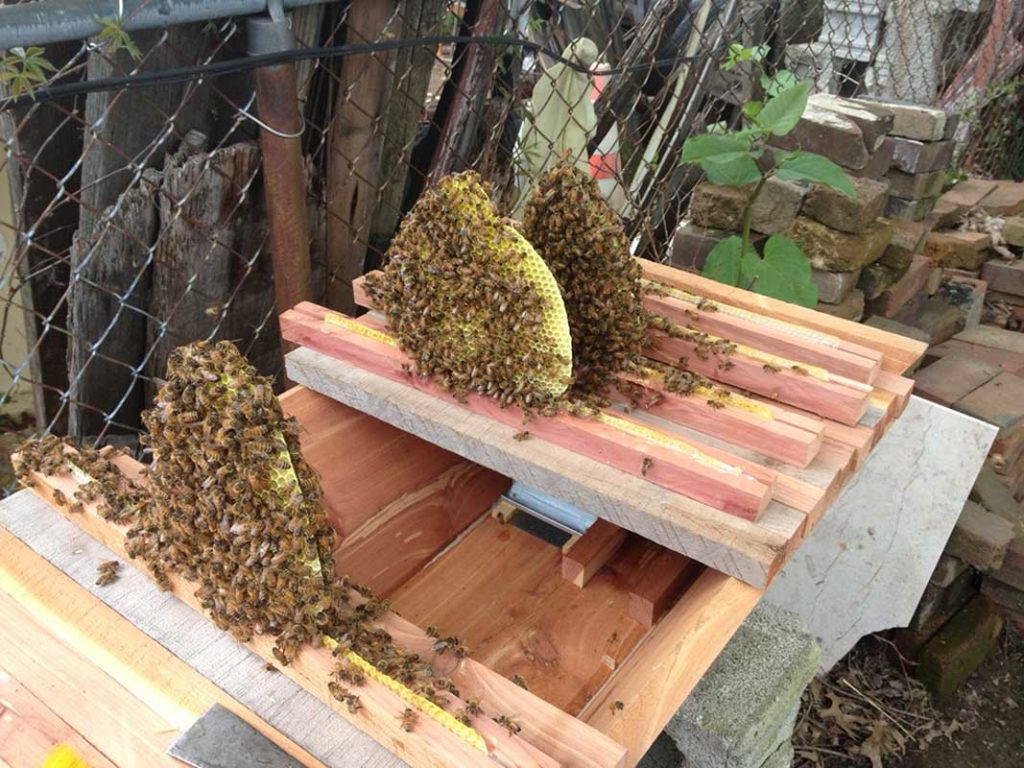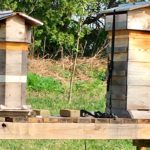The Amos Farm
All A’Buzz Beehives
by Christian Torp
First off, before you get your beehives going, don’t forget to get your Maine apiary license: http://www.maine.gov/DACF/php/apiary/documents/2017ApiaryApplication.pdf
I was drawn to all the wrong things: I liked to drink, I was lazy, I didn’t have a god, politics, ideas, ideals. I was settled into nothingness; a kind of non-being, and I accepted it. I didn’t make for an interesting person. I didn’t want to be interesting, it was too hard. What I really wanted was only a soft, hazy space to live in, and to be left alone. –Charles Bukowski
Now where would YOU like to live if you were a bee?
Langstroth Hives
Of modern beehives the Langstroth is the standard. They feature common, interchangeable components, the ability to share with other bee keepers, and the are rugged. In fact, pollination businesses strap them onto open semi-trailers and go flying down the interstate at 70 mph.
Patented in 1852 by the Reverend Lorenzo Lorraine Langstroth, it is a vertically integrated hive with removable frames built upon the then revolutionary idea of “bee space.” The reverend noticed that bees would neither build comb nor seal with propolis (resinous plant substance) an area 3/8 inch wide. And he reckoned that if a hive was built around that dimension it would remain free and accessible.
Langstroth beehives have changed since then, and are today standardized into three frame sizes (shallow 19” inches x 5-3/8”; medium 19” x 6 1/4”; deep frames 19” x 9 1/8”) in either 8 or 10 frame boxes. Typically beekeepers utilize two deep boxes for the brood box, and shallow or medium boxes for the honey supers. The brood box is where the bees produce their young and keep food for the winter. And what’s in the honey supers is for you. I use three mediums for my brood box, as well as mediums for honey supers.
Downsides? To harvest honey you’ll need access to a honey extractor, an investment of hundreds. That is if there’s no local bee club around to borrow one from. Or you’ll need to keep your honey supers foundation-less and do the top bar cut and smoosh method (see below). But this method negates the possibly of greater production.
Also, both Langstroth and Warre beehives require the lifting and manipulation of hive boxes which can weight in excess 90 lbs. With a Langstroth new boxes are added to the top, which doesn’t require picking up the whole hive and putting it on top of the new box — as with a Warre. But, they’ve got to be picked up nonetheless. I am disabled and don’t have the use of my right arm (although my hand works) and I don’t have trouble lifting my hives. Of course, I’m also young and perform manual labor often. If you have limited mobility you might want to look toward the top bar.
Top Bar Hives
There is no standardization around top bar hives. You might say they’re a blank canvas. As such they offer minimal interchangeability. If you have hive trouble it’s a blessing to find another beekeeper who has top bars that’ll fit your hive, so that you can introduce new resources if need be. Also, it is thought that top bars are a more natural way to keep bees. So, the argument goes that the bees are generally calmer. Finally, top bars require no heavy lifting, as each frame is removed individually for inspection.
If it’s more natural, why do it any other way? For one, harvesting from a top bar is by the previously mentioned “cut and smoosh” method. The comb is cut from the top bars and crushed into some type of sieve separating your wax and honey. Because of this you’re bees can never use that comb again. Yet, the hive’s investment in making one pound of wax is equivalent to about 8 pounds of honey!
Secondly, top bars require frequent inspection. As good as your method of ensuring straight comb may be, one day your bees will build their comb at an angle across multiple frames and “cross comb.” If caught early enough frames may be separated. If not, your only option is to harvest that block of frames, no matter if it’s all honey or all brood.
Top bar frames are also exceedingly fragile. In fact, they must be rotated to the side to be inspected because the weight of the comb and its contents is often enough to bend the comb to the ground. Especially so on warm days… And then there’s the real summer disaster – when most of your hive has separated from the top bars and collapsed in a gooey mess inside your hive! When this happens, the honey may be salvageable, but the bees, eggs, larvae, brood and possibly the queen contained in the gooey mess, are goners.
Nevertheless, some beekeepers believe they get just as much honey from a top bar as a Langstroth, and some even keep them commercially.
If you can, check out Wyatt Mangum’s Top-Bar Hive Beekeeping: Wisdom & Pleasure Combined.
To see one of my top bars check out the May/June 2016 issue of Hobby Farms Magazine: http://www.hobbyfarms.com/build-a-top-bar-beehive/
Warre Hives
The Warre hive (pronounced “wah REY”) is named after it’s inventor, Abbé Émile Warré (1867-1951), a French Monk who made it his work to study the bee and replicate their natural ways as closely as possible. He devised what some call a “vertical top bar hive,” wherein the bees make their own comb without any foundation. Instead, new boxes are added to the bottom with a box of woodshavings on top between two layers of cotton quilting for moisture control.
A Warre hive requires the least maintenance and potentially provides the most suitable internal environment for the bees of any of the hives types. It is said to be perfect for a minimally maintained use such as garden pollination.
Honey production with a Warre is said to be half that of a Langstroth. Do to construction complexity, reduced honey yields and extremely limited fiddling opportunities, I have not built a Warre hive. But, I have spoken to Ms. Patrice Beal who lent me the following insights:
Patrice has been keeping bees in a Warre for four years as she found that a Warre was the most suitable type of hive for her due to philosophical reasons. Her interest in beekeeping is predicated on enjoyment and aiding bees in nature and improving their genetics.
She finds that a Warre is the most suitable hive for her. And she enjoys how, as in nature, the bees travel downward throughout the season laying brood in new comb and then filling that comb with honey after their young have been reared.
There is no maintenance or intervention necessary in her Warre hives. All that is necessary is for her to harvest the honey. Also, she informs me that some Warre beekeepers add a shallow Warre box atop the hive to accumulate the colony’s excess honey for fall harvest.
It is thought that due to improved efficiency and a more natural design colonies overwintering in Warre beehives need less honey stores to survive.
Building or buying?
I started bee keeping with top bar hives. I figured they would be the easiest to build, and the quality of commercially built hives (Langstroth) that I have seen is extremely poor.
Also, I chose the top bar because the bees build their own comb to fit their needs (also true of a Warre hive). There is discussion that the size of the cells on foundation is unnatural and leads to increased hive parasites and potentially leads to the introduction of toxins as the wax used is from an unknown source.
I have since also built Langstroth hives (purchased the frames) and enjoy keeping my bees that way very much.
What is there to say?
In choosing which style of beehives you’d like, think first of your intended purpose and how much time you can dedicate to your apiary. During the season, top bar hives require inspections at least twice a week. Whereas a Warre hive may require only one annual inspection.
If you’re looking for honey production, you probably should focus on a Langstroth. It requires 8 pounds of honey to make a pound of wax, so you’ll get 8 more ounces of honey every time your bees reuse an ounce of wax.
Read Beekeeping Part I Tools and Resources here.
 Christian L. Torp
Christian L. Torp
Christian is an attorney, missionary, activist, urban-farmer, foster parent and advocate for social change who lives at Justice House (facebook: Justice House) with his wife, Tanya in Lexington, KY. If you have any questions or comments for Christian, or there’s something you’d like to know more about, please reach out to him at theamosfarm@gmail.com.
If you have any questions or comments for Christian, or there’s something you’d like to know more about, please reach out to him at theamosfarm@gmail.com.







